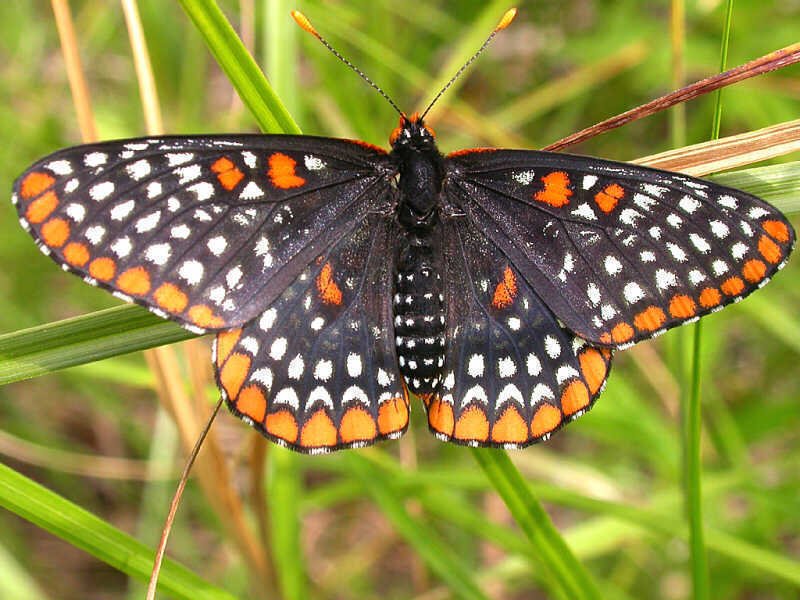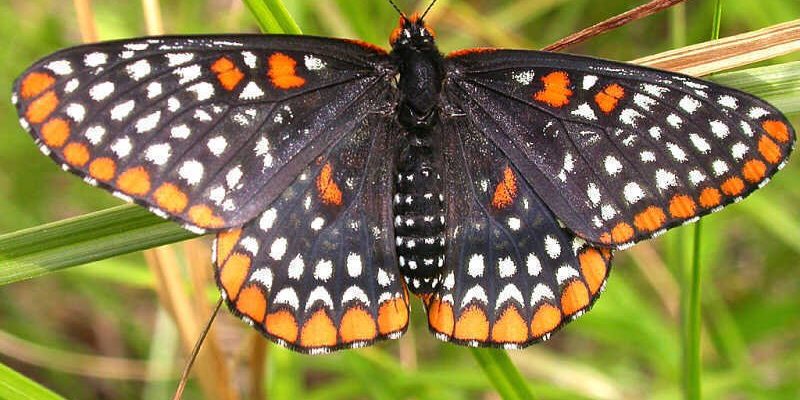
If you find yourself wandering through a sunny meadow in the eastern United States, you might catch a glimpse of the stunning Baltimore Checkerspot Butterfly. Known for its vibrant orange and black patterned wings, this butterfly is not just a pretty sight; it’s a fascinating creature with an important role in our ecosystem. With its unique lifecycle and specific habitat requirements, the Baltimore Checkerspot isn’t just another butterfly; it’s a symbol of the beauty and fragility of nature.
The Baltimore Checkerspot Butterfly, or Euphydryas phaeton, primarily resides in wet meadows and marshes, making it a creature closely tied to specific habitats. They are most famous for the distinctive checkered patterns on their wings, which can remind you of a colorful patchwork quilt. Whether you’re an avid butterfly enthusiast or simply someone who enjoys the wonders of nature, learning about this butterfly can open your eyes to the delicate balance of life in our environment.
Physical Characteristics
The Baltimore Checkerspot Butterfly is a medium-sized butterfly, with a wingspan of about 2 to 3 inches. Its upper wings feature a beautiful array of orange and black colors, resembling an artist’s palette splashed with vivid hues. The male butterfly usually presents a more vibrant coloration than the female, which can sometimes appear slightly duller. The pattern of white spots on the wings adds to its charm and can help in identifying the species.
On the underside, the wings have a more muted tone, with a brownish color that’s speckled with orange and white. This coloration serves a practical purpose, allowing the butterfly to blend into its surroundings when resting on plants. It’s essential for avoiding predators and ensuring their survival. Just imagine how invisibly these butterflies can rest amidst the flowers and grasses, camouflaged against the backdrop of nature!
In addition to their striking appearance, the antennae of the Baltimore Checkerspot are long and slender, helping them navigate their environment with precision. This sensory adaptation is vital for locating food and mates, showcasing how form and function beautifully combine in nature.
Life Cycle and Behavior
The life cycle of the Baltimore Checkerspot Butterfly is nothing short of fascinating. Like all butterflies, they undergo a complete metamorphosis, which includes four distinct life stages: egg, larva (caterpillar), pupa (chrysalis), and adult butterfly. The females lay their eggs on specific host plants, primarily Plantago lanceolata, also known as plantain. This is a crucial relationship since the caterpillars exclusively feed on these plants.
After hatching, the caterpillars go through several molts, growing larger with each stage. They are known for their distinctive black and yellow markings, which serve as a warning to predators about their unpalatable taste. This survival strategy is a clever way of using coloration to ward off potential threats. It’s like wearing a sign that says, “Don’t eat me!”
As the caterpillars mature, they eventually enter the pupal stage, where they transform into chrysalises. During this time, they undergo significant changes, emerging later as the magnificent butterflies we admire. This whole process takes several weeks, and it’s a mesmerizing journey that showcases the wonders of nature’s design.
Habitat and Distribution
The Baltimore Checkerspot Butterfly thrives in specific habitats that provide the necessary conditions for their survival. They are predominantly found in wetlands, wet meadows, and marshy areas, particularly in states like Maryland, Virginia, and Delaware. These habitats are essential not just for the butterflies but also for the host plants they rely on.
These butterflies prefer sunny areas where they can bask in the warmth and find plenty of nectar from flowering plants. This preference for warm, open spaces makes them especially vulnerable to habitat destruction. As human activity continues to encroach on natural landscapes, these butterflies face the daunting challenge of finding suitable living conditions.
Climate plays a significant role in their distribution as well. Changes in weather patterns can disrupt their lifecycle, leading to population declines. Keeping a close eye on these environmental factors is crucial for conservation efforts to preserve their habitats and ensure the survival of the Baltimore Checkerspot.
Diet and Feeding Habits
The diet of the Baltimore Checkerspot Butterfly varies throughout its life cycle. As caterpillars, they primarily feed on the leaves of host plants, particularly the plantain leaf mentioned earlier. These caterpillars are quite specific about their diet, which is essential for their growth and development. You can think of them as picky eaters, only choosing certain plants that provide the nutrients they need.
Once they emerge as adult butterflies, their diet shifts to nectar. They visit various flowering plants, sipping on the sweet nectar with their long proboscis. This relationship is mutually beneficial; as they feed, they help with pollination, transferring pollen from one flower to another. It’s a beautiful dance of nature that underscores the interconnectedness of life.
Interestingly, their diet can influence their behavior as well. On warm days, you might find them flitting from flower to flower, but they also have preferences for certain types of blooms based on their nutritional needs. Ensuring a mix of native flowers in their habitat can encourage a healthy population of Baltimore Checkerspot Butterflies.
Conservation Status
Unfortunately, the Baltimore Checkerspot Butterfly is facing significant threats. Due to habitat destruction, climate change, and other environmental stresses, its population has declined sharply in recent years. This decline has placed them on various conservation watch lists, highlighting the urgency of protecting their habitats. It’s a stark reminder of how fragile our ecosystems can be.
Conservation efforts are underway to help protect this beautiful butterfly. Organizations work to restore wetland habitats, create awareness about the importance of preserving natural environments, and encourage local communities to participate in conservation activities. Every effort counts in ensuring that this butterfly and its ecosystem remain intact for future generations.
On a positive note, there are ways you can contribute to conserving the Baltimore Checkerspot. By planting native flowers and maintaining a healthy habitat in your garden, you can help create a welcoming environment for these butterflies and many other pollinators. Remember, small actions can lead to big changes!
Interesting Facts
| Wingspan: | 2 to 3 inches |
| Primary Habitat: | Wet meadows and marshes |
| Diet: | Caterpillars feed on plantain leaves; adults feed on nectar |
| Life Cycle Duration: | Several weeks from egg to butterfly |
| Conservation Status: | Threatened |
How to Spot a Baltimore Checkerspot Butterfly
Spotting a Baltimore Checkerspot Butterfly can be a delightful experience, but it requires a bit of patience and knowledge. First, look for them in their preferred habitats, such as wet meadows and areas with plenty of blooming flowers. The best time to see them is during the warm months of late spring to early summer when they are most active.
When you’re in the right place, keep your eyes peeled for their striking orange and black wings. If you see a butterfly darting from flower to flower or basking in the sun, there’s a good chance it could be a Baltimore Checkerspot. Pay attention to their movements; they tend to puff out their wings when resting, making their vibrant colors pop even more.
Using a pair of binoculars can enhance your chances of spotting them without disturbing their natural behavior. Also, try to move quietly and slowly; sudden movements can scare them away. Consider bringing a guidebook or using a butterfly identification app, so you can confirm your sighting. The thrill of spotting one of these butterflies is truly a rewarding experience that connects you with the wonders of nature.
FAQ
What is the habitat of the Baltimore Checkerspot Butterfly?
The Baltimore Checkerspot Butterfly primarily inhabits wet meadows and marshes, thriving in areas where specific host plants like plantain are available. These habitats provide the necessary conditions for their survival, including ample food sources and a warm climate.
How can I help conserve the Baltimore Checkerspot Butterfly?
There are several ways you can contribute to the conservation of the Baltimore Checkerspot. Planting native flowers, maintaining wetland areas, and participating in local conservation efforts can all make a significant difference. Every small action counts, and creating a welcoming environment for butterflies can help their population thrive.
When is the best time to see the Baltimore Checkerspot Butterfly?
The best time to spot the Baltimore Checkerspot Butterfly is during the late spring to early summer months when they are most active. During this time, they are busy feeding and mating, making them easier to observe in their natural habitats.
What do Baltimore Checkerspot caterpillars eat?
Baltimore Checkerspot caterpillars primarily feed on the leaves of plantain plants, which are crucial for their growth and development. This specific diet is essential for their life cycle, and they will only feed on certain plants that provide the nutrients they need.
Are Baltimore Checkerspot Butterflies endangered?
The Baltimore Checkerspot Butterfly is considered threatened due to habitat loss and environmental changes. Conservation efforts are in place to protect their habitats and monitor populations to ensure that these beautiful butterflies can continue to thrive in the wild.
What role do Baltimore Checkerspot Butterflies play in the ecosystem?
Baltimore Checkerspot Butterflies play an important role in their ecosystem by acting as pollinators. As they feed on nectar from various flowers, they help transfer pollen, contributing to plant reproduction and the overall health of their habitats. This relationship is vital for maintaining biodiversity.
How long do Baltimore Checkerspot Butterflies live?
The lifespan of a Baltimore Checkerspot Butterfly typically lasts a few weeks to a couple of months, depending on environmental conditions and predator pressures. However, their complete life cycle from egg to butterfly can take several weeks.

